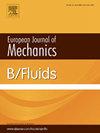Simulation analysis of flow field optimization for powder bed surface integrity and spatter particle removal
IF 2.5
3区 工程技术
Q2 MECHANICS
引用次数: 0
Abstract
Spatter particles are a major cause of part defects during laser powder bed fusion (LPBF). Filling the working chamber with an inert gas prevents oxidation of the part and simultaneously removes spatter particles. The flow of inert gas in the working chamber influences the spatter-particle trajectory. This study develops a new wind-duct circulation system design based on inert-gas flow characteristics. The inert gas flow characteristics in the chamber were investigated using a coupled computational fluid dynamics and discrete phase model. The Coanda effect influence on the wind field uniformity and motion trajectories of spatter particles in different regions of the LPBF chamber was analyzed. A Bernoulli-effect three-wind duct structure was designed to attenuate the Coanda effect, and the effects of nine sets of wind speed combinations were investigated. The results demonstrate that the newly designed three-wind duct structure effectively reduces the Coanda effect of the flow field inside the working chamber. Wind speed requirements in each functional area are ensured and the removal efficiency of spatter particles is enhanced (79–96 %). This solution addresses a critical issue found in existing commercial LPBF equipment, providing a reliable reference for the subsequent optimization and design of duct circulation systems.
求助全文
约1分钟内获得全文
求助全文
来源期刊
CiteScore
5.90
自引率
3.80%
发文量
127
审稿时长
58 days
期刊介绍:
The European Journal of Mechanics - B/Fluids publishes papers in all fields of fluid mechanics. Although investigations in well-established areas are within the scope of the journal, recent developments and innovative ideas are particularly welcome. Theoretical, computational and experimental papers are equally welcome. Mathematical methods, be they deterministic or stochastic, analytical or numerical, will be accepted provided they serve to clarify some identifiable problems in fluid mechanics, and provided the significance of results is explained. Similarly, experimental papers must add physical insight in to the understanding of fluid mechanics.

 求助内容:
求助内容: 应助结果提醒方式:
应助结果提醒方式:


